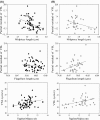Variability in sperm form and function in the context of sperm competition risk in two Tupinambis lizards
- PMID: 25505535
- PMCID: PMC4242561
- DOI: 10.1002/ece3.1262
Variability in sperm form and function in the context of sperm competition risk in two Tupinambis lizards
Abstract
In polyandrous species, sperm morphometry and sperm velocity are under strong sexual selection. Although several hypotheses have been proposed to explain the role of sperm competition in sperm trait variation, this aspect is still poorly understood. It has been suggested that an increase in sperm competition pressure could reduce sperm size variation or produce a diversity of sperm to maximize male fertilization success. We aim at elucidating the variability of sperm morphometric traits and velocity in two Tupinambis lizards in the context of sperm competition risk. Sperm traits showed substantial variation at all levels examined: between species, among males within species, and within the ejaculate of individual males. Sperm velocity was found to be positively correlated with flagellum: midpiece ratio, with relatively longer flagella associated with faster sperm. Our results document high variability in sperm form and function in lizards.
Keywords: Postcopulatory sexual selection; Squamata; sperm evolution; sperm morphometry; sperm velocity.
Figures




References
-
- AVMA, Guidelines on Euthanasia. Formerly report of the AVMA panel on euthanasia. 2007. American Veterinary Medical Association. http://www.avma.org/issues/animal_welfare/euthanasia.pdf.
-
- Bakker TCM, Hollmann M, Mehils M, Zbinden M. Functional variation of sperm morphology in sticklebacks. Behav. Ecol. Sociobiol. 2014;68:617–627.
-
- Ball MA, Parker GA. Sperm competition games: external fertilization and ‘adaptive’ infertility. J. Theor. Biol. 1996;180:141–150. - PubMed
-
- Biggers JD, Whitten WK. The culture of mouse embryos in vitro. In: Daniel JC, Whittingham DG, editors. Methods in mammalian embryology. San Francisco, CA: Freeman; 1971. pp. 86–116.
-
- Birkhead TR, Møller AP. Sexual selection and the temporal separation of reproductive events: sperm storage data from reptiles, birds and mammals. Biol. J. Linn. Soc. 1993;50:295–311.
LinkOut - more resources
Full Text Sources
Other Literature Sources

